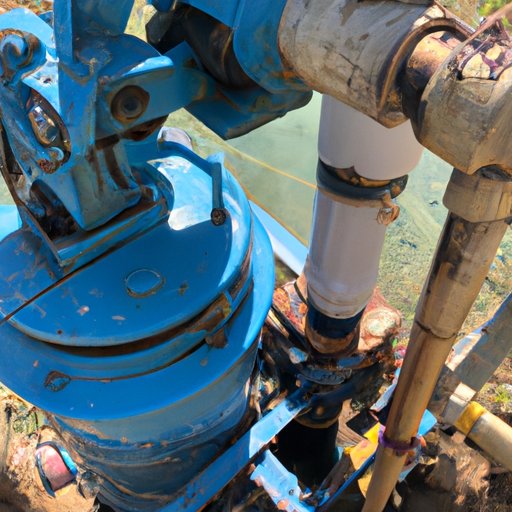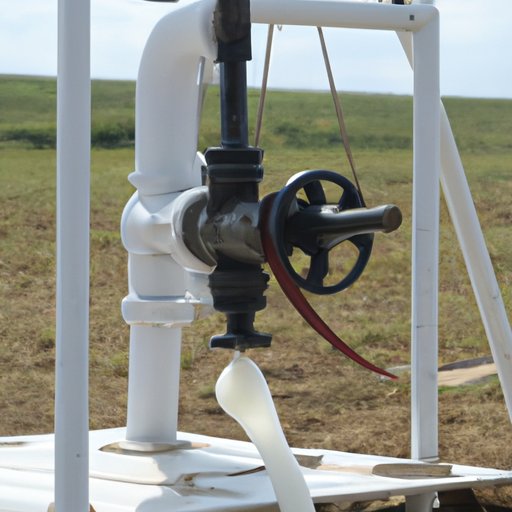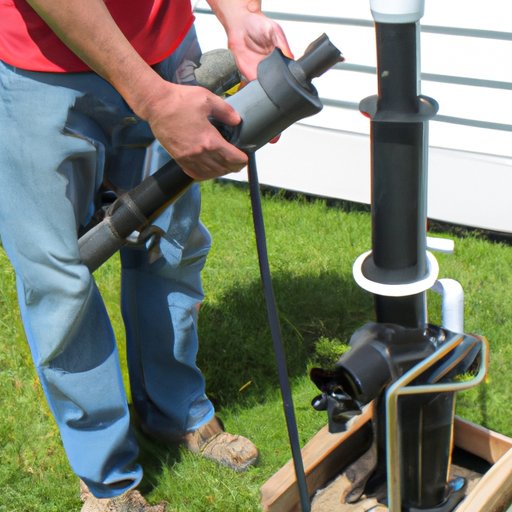Introduction
Priming a well pump is an important procedure for ensuring that your water pump is working properly. Without priming, your well pump won’t be able to draw water up from the well and into your home. This article will provide a comprehensive guide on how to prime a well pump, from understanding the basics and assembling the necessary equipment to step-by-step instructions and troubleshooting tips.
What is Priming a Well Pump?
Priming a well pump involves filling the pump with water in order to force air out of the pump and create suction. This suction is what allows the pump to draw water up from the well and into your home. If you don’t prime your well pump, it won’t be able to draw water up from the well and into your home.
Benefits of Knowing How to Prime a Well Pump
Priming a well pump is an essential part of maintaining your home’s water system. It ensures that your well pump is functioning properly and drawing the right amount of water from the well. Additionally, knowing how to prime a well pump can save you money by avoiding costly repairs and service calls. According to research published in the Journal of Water Resources Planning and Management, “Well pumps are expensive to replace and it is beneficial to have them serviced regularly to ensure their longevity.”
Step-by-Step Guide to Priming a Well Pump
Priming a well pump requires a few steps, but it’s not difficult. Here are the steps you should take to prime your well pump:
Preparing the Well Pump for Priming
Before you begin priming the well pump, you need to make sure the pump has been disconnected from the power source. This will help avoid any potential electrical hazards. Additionally, you should check the pressure gauge to make sure the pressure is at zero.
Locating the Inlet and Outlet Valves
Once the pump is disconnected from the power source, you need to locate the inlet and outlet valves. The inlet valve is usually located at the top of the pump and the outlet valve is usually located at the bottom. You may need to refer to your pump’s manual in order to locate these valves.
Connecting the Suction Hose
Next, you need to connect the suction hose to the inlet valve. Make sure the hose is securely connected and there are no leaks. Once the hose is connected, you can move on to the next step.
Opening the Air Bleed Valve
The air bleed valve is located at the top of the pump and should be opened before you start the priming process. Opening the valve will allow air to escape from the pump and help create a vacuum.
Starting the Priming Process
Once the air bleed valve is open, you can start the priming process. You will need to pour water into the pump until it reaches the desired level. You can use a bucket or a garden hose to do this.
Finishing the Priming Process
Once the water has reached the desired level, close the air bleed valve and turn on the power to the pump. The pump should start running and the pressure gauge should start to rise. If the pressure doesn’t rise, the pump isn’t primed correctly and you may need to repeat the process.

Troubleshooting Tips for Priming a Well Pump
If you’re having trouble priming your well pump, there are a few things you can do to try and fix the problem. Here are some troubleshooting tips for priming a well pump:
Checking the Pressure Gauge
If the pressure gauge isn’t rising after you’ve finished priming the pump, the pump may not be primed correctly. Try priming the pump again and checking the pressure gauge. If the pressure still isn’t rising, the problem may be with the pump itself and you may need to call a professional.
Examining the Suction Line
If the suction line is blocked or clogged, the pump won’t be able to draw water up from the well. Check the suction line for any blockages or clogs and remove them if necessary.
Inspecting the Check Valve
The check valve is an important part of the well pump and needs to be inspected regularly. If the check valve is faulty or damaged, it may be preventing the pump from priming correctly. Check the check valve for any signs of damage and replace it if necessary.

Priming a Well Pump: What You Need to Know
Priming a well pump is an important part of maintaining your home’s water system. Before you begin, it’s important to understand the basics and have the necessary tools and safety precautions in place. Here’s what you need to know about priming a well pump:
Common Causes of Poor Priming Performance
Poor priming performance can be caused by a number of factors, including a clogged suction line, a faulty check valve, or a worn-out pump. Be sure to inspect all of these components before beginning the priming process.
Necessary Tools for Priming a Well Pump
You will need a few basic tools in order to prime a well pump, including a bucket or garden hose, a wrench, and a screwdriver. Additionally, you may need to consult your pump’s manual in order to locate the inlet and outlet valves.
Safety Precautions for Priming a Well Pump
It’s important to follow proper safety precautions when priming a well pump. Make sure the pump is disconnected from the power source before beginning, and wear protective gear such as gloves and goggles while handling the pump.
A Beginner’s Guide to Priming a Well Pump
Priming a well pump can seem daunting, especially if you’re a beginner. But with the right tools and knowledge, anyone can prime a well pump. Here’s a beginner’s guide to priming a well pump:
Understanding the Basics
The first step is to understand the basics of priming a well pump. This includes understanding what priming is, why it’s necessary, and what tools and safety precautions are needed.
Assembling the Necessary Equipment
Once you understand the basics, you can assemble the necessary equipment. This includes a bucket or garden hose, a wrench, and a screwdriver. You may also need to consult your pump’s manual in order to locate the inlet and outlet valves.
Performing the Priming Procedure
Once you have all the necessary equipment, you can begin the priming procedure. This includes preparing the pump, locating the inlet and outlet valves, connecting the suction hose, opening the air bleed valve, starting the priming process, and finishing the priming process.

How to Prime a Well Pump in 8 Easy Steps
Priming a well pump doesn’t have to be difficult. Here are 8 easy steps to prime a well pump:
Step 1: Prepare the Well Pump
Disconnect the pump from the power source and check the pressure gauge to make sure the pressure is at zero.
Step 2: Locate the Inlet and Outlet Valves
Locate the inlet and outlet valves. The inlet valve is usually located at the top of the pump and the outlet valve is usually located at the bottom.
Step 3: Connect the Suction Hose
Connect the suction hose to the inlet valve. Make sure the hose is securely connected and there are no leaks.
Step 4: Open the Air Bleed Valve
Open the air bleed valve located at the top of the pump.
Step 5: Start the Priming Process
Pour water into the pump until it reaches the desired level. You can use a bucket or a garden hose to do this.
Step 6: Finish the Priming Process
Close the air bleed valve and turn on the power to the pump. The pump should start running and the pressure gauge should start to rise.
Step 7: Check the Pressure Gauge
Check the pressure gauge to make sure the pressure is rising. If the pressure isn’t rising, the pump isn’t primed correctly and you may need to repeat the process.
Step 8: Examine the Suction Line
Check the suction line for any blockages or clogs and remove them if necessary.
Conclusion
Priming a well pump is an important part of maintaining your home’s water system. Knowing how to prime a well pump can save you time and money and prevent costly repairs. This article provided a comprehensive guide on how to prime a well pump, from understanding the basics and assembling the necessary equipment to step-by-step instructions and troubleshooting tips. With the right knowledge and tools, anyone can prime a well pump.
(Note: Is this article not meeting your expectations? Do you have knowledge or insights to share? Unlock new opportunities and expand your reach by joining our authors team. Click Registration to join us and share your expertise with our readers.)
